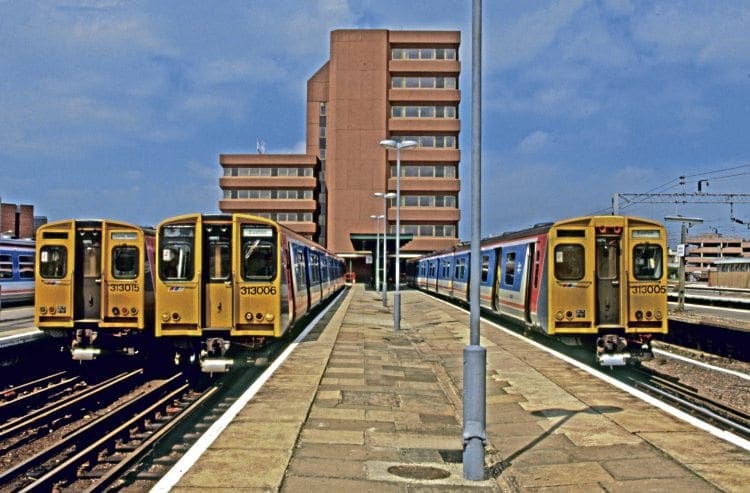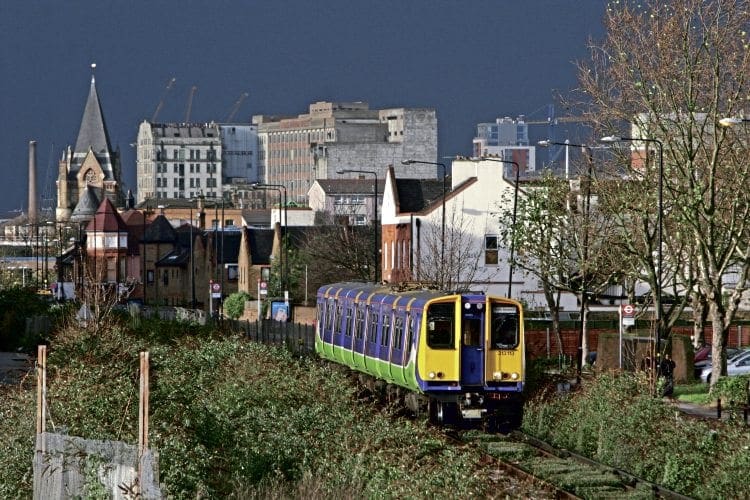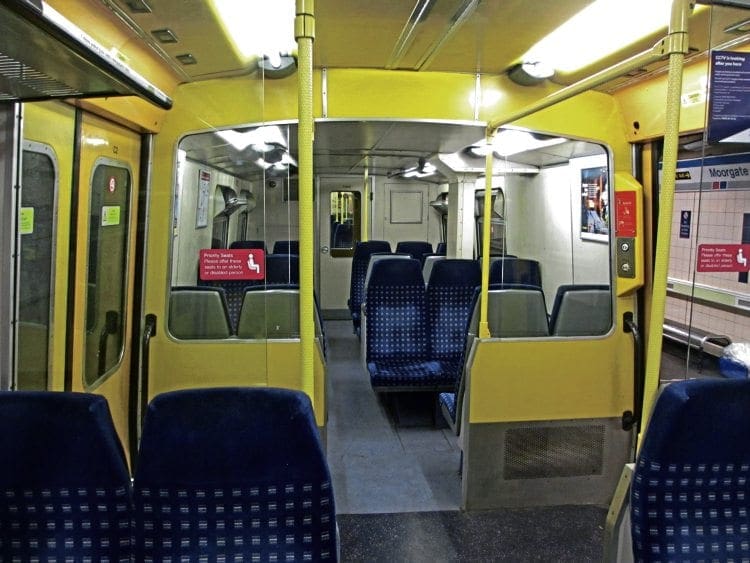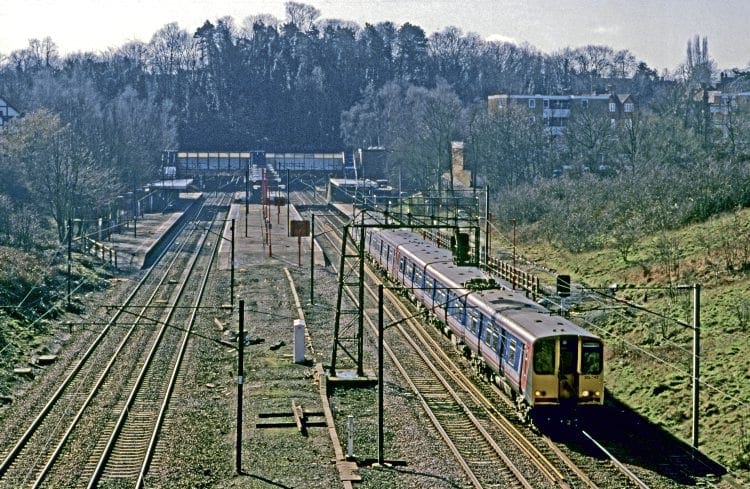On November 8 this year the Class 313 EMUs will have been in service for 40 years. Originally designed for one short line, with unusual requirements, their versatility and durability has meant that they have all survived and have seen redeployment elsewhere, as Quentin Williamson explains.
ALTHOUGH British Railways had greatly extended electric traction since its formation in 1948, its approach to Electric Multiple Unit (EMU) design had been conservative and derivative.
Its Mk1 coaching stock had originally been developed from the latest Southern Railway designs and EMUs were powered versions of the Mk1 designs.

From the mid-1960s the Mk2 designs emerged for locomotive-hauled stock, and outer suburban EMU versions appeared on Euston to Birmingham and Manchester semi-fast services as Class 310. Later, similar Class 312 units beefed up services from Liverpool Street, largely in the direction of Clacton. Nevertheless the Southern Region still received new Class 423 sets, which, although fitted with toilets, differed little from EMUs built by the Southern Railway in the 1930s. In 1972 three prototype EMUs, built to a radical new design, were tested on the Southern Region. A two-car and two four-car units were tried out in service, becoming Class 445 (4Pep) and Class 446 (2Pep).
Monthly Subscription: Enjoy more Railway Magazine reading each month with free delivery to you door, and access to over 100 years in the archive, all for just £5.35 per month.
Click here to subscribe & save
They featured doors in the front of the driving cabs for people to leave the train in an emergency in tunnels, automatic couplings, which carried all of the connections in the coupling, broad sliding doors, and low backed seats in entirely saloon accommodation.
The bodies were built from aluminium alloy and steel.
Operational problems
However, it was not on the Southern Region where the production version of the Class 445 prototype was to be used. There had long been a problem with accommodating suburban trains from the old Great Northern Railway at King’s Cross, not least because the GNR ought to have electrified its suburban trains, but never quite got round to it.
As long ago as 1892 the Great Northern & City Railway was built by a firm of contractors called S Pearson. This ran from Finsbury Park station on the GNR main line to Drayton Park, from where a tube tunnel to 16ft diameter ran to its terminal at Moorgate. This was the only main-line loading gauge tube tunnel in London, the other tube lines having tunnels of 11ft 8¼in, because it was meant for GNR trains to be worked through to Moorgate. Indeed, in due course they were, but by way of King’s Cross and the Metropolitan Line, and worked by steam locomotives fitted with condensing apparatus.
So the Great Northern & City Railway opened on February 13, 1904 as a shuttle service from Moorgate to a station beneath the GNR’s Finsbury Park station, and was worked by Britain’s first all-steel trains. It was taken over by the Metropolitan Railway in 1913 and by 1975 was worked by six-car trains of 1938 tube-sized stock. It was all quite a lost opportunity.
Even worse, on February 28, 1975, at 08.45, a Tube train smashed in to the end of the tunnel at Moorgate. The driver had not slowed the train for the stop and the 22-yard sand drag and tripcock emergency braking system did not prevent the disaster.

It caused the greatest loss of life during peacetime on the London Underground, with 43 people killed and a further 74 injured. An inspection of the train and other railway equipment found no faults and the accident was put down to driver error.
By the 1970s Great Northern suburban services were worked by a motley collection of DMUs, which had been meant for rural lines in East Anglia and elsewhere, but had become available in the wake of the Beeching Report.
Many of them were unsuitable, having fewer doors and seats than purpose-built DMUs. During rush hours such trains were backed up by through trains over the widened lines of the Metropolitan, formed from old-fashioned slam-door suburban carriages worked by Class 31 diesel locomotives, with some of the carriages stabled as far away as Hertford North for most of the day.
These were a source of delight to enthusiasts and dismay to operating staff.
As if by magic
The Class 313 solved all of the problems. The Great Northern electrification was largely on the 25kV overhead catenary system for which the 313s were fitted with pantographs. However, the 16ft tunnels of the old GN&CR had too little clearance for catenary to be installed, so the line from Drayton Park to Moorgate was electrified on the 750v DC third-rail system used on the Southern Region, Merseyrail and suburban lines from Broad Street and Euston to Watford and Croxley Green. Even so the new trains had to be built with slightly lower roofs than standard loading gauge would allow.
The new trains were fitted with pick-up shoes for this traction system too, which meant that suburban trains could work through to Moorgate. The loco-hauled trains from there could then be withdrawn and pressure eased at King’s Cross. The 313s work in to Drayton Park from Hertfordshire, powered from the overhead catenary, and can work at up to 75mph. The driver then lowers the pantograph and the 313s switch to the third-rail supply: the maximum speed is then limited to 30mph automatically.
Disc and rheostatic brakes are fitted, which gives automatic bias to the rheostatic brakes, except below 16mph when the disc brakes take over completely. The rheostatic brakes are fitted to the motor cars, but not to the middle pantograph cars. The body design, derived from the Class 445 prototypes, is built from aluminium alloy and steel, improving acceleration, lessening the tare and saving power.
The trains were also built without a brakevan area for sundry cargo, such as newspapers or mail bags, which had been a feature of previous EMUs, so all of the space could be used to carry passengers – even if this area beneath the pantograph can be rather noisy to travel in.
The guard rode in the back cab. Two sets of sliding doors on each carriage are fitted at the one-third and two-thirds positions, which had proved to be effective at reducing dwell times and mechanical stress on the bogie mountings.
To help passengers even more with getting on or off, the doors open to 5¼ft instead of the former 3¾ft sliding door gap, or the 2ft 2in of the slam-door DMUs formerly working trains from King’s Cross. The doors were to be opened by passengers pulling at handles fitted to them where the leaves joined, which activated a magnetic reed switch to open the doors pneumatically. However, impatient Hertfordshire and North London passengers were wont to ‘yank’ the doors open, even when trains had not come to a stop; they were soon altered to be opened and closed all at once by the guard.

Yet another improvement brought by the 313s was better riding from the fitting of modern suspension worked by rubber chevron springs with oil dampers supported by twin air bellows on each bogie. The bellows let the train rise or sink slightly according to the load.
The previous BR build of inner-suburban EMUs in 1966 (Class 311) were mounted on Gresley double-bolster bogies, originally designed in 1906.
Sixty-four Class 313s were built by British Rail Engineering Ltd at York, with the first entering service on November 8, 1976, and were a great success. Operating as far as Welwyn Garden City they were backed up by outer-suburban Class 312s which, however, could not work between Moorgate and Finsbury Park.
After a few years the lavish suburban services on the Great Northern lines were thinned out which, with more effective rostering, meant that fewer units were needed and became available for deployment elsewhere. Given that they were designed with a special three-mile section of railway in mind the versatility this gave the units has led to them working trains surprisingly widely in Southern England.
Their first excursion away from the GNR lines was a short one to the Midland lines from St Pancras to Bedford when this was electrified in 1981 and too few of its new Class 317 trains were available to work all services at the time of a driver-only operation dispute.
A longer sojourn was when 16 sets were transferred to the former LNWR DC-worked lines from Broad Street, Euston and Richmond in May 1985 to replace the Class 501 EMUs, dating from May 1957. These 501s were known as ‘gaol trains’ as they had to be fitted with bars over the droplight windows because of narrow clearances in Hampstead Heath tunnel.
The replacement 313s were fitted with extra pick-up shoes on the outer bogies of the DMS coaches to cope with longer gaps in the third rail on the former LMS lines. Their dual-voltage capabilities meant that they could be worked easily from Bletchley depot, allowing Croxley Green depot to be closed.
At the same time the ‘gaol trains’ working the Richmond to Broad Street and later North Woolwich services were replaced by older Bulleid-style 2EPBs, which had to have the bars over the windows fitted to them. These too were later replaced by Class 313s.
Four Class 313s were also transferred to Clacton. The line from Colchester to Clacton forks at Thorpe-le-Soken, where the main route heads for Clacton and a single-track branch line goes on to Walton-on-the-Naze by way of Kirby Cross, where there is a passing loop, and Frinton-on-Sea.

It was worked by Class 309 EMUs, with two-car sets serving Walton-on-the-Naze, combining at Thorpe-le-Soken with four-car trains from Clacton for the onward journey to Liverpool Street. However, the 309s were being renovated to remove dangerous blue asbestos insulation from them and the 313s filled the rolling stock gap by working a shuttle service from Thorpe-le-Soken to Walton-on-the-Naze.
The 750v shoe gear was removed and the rheostatic brakes disconnected, although it was later reinstated, which pleased the drivers.
Nevertheless, on August 12, 1987, No. 313063 smashed through the buffers at Walton-on-the Naze at about 25mph and ploughed into the station buildings. Luckily, no-one was in the toilets when the train struck and although the leading DMSO No. 62655 was badly damaged, the rest of the train was not. Seven people were injured.
The subsequent accident investigation by Major CB Holden found that although the brake controller had a faulty relay in its code conversion unit, which may have stopped the first brake position from working, the driver ought to have realised this sooner and applied the emergency brake, which would have stopped the train before it hit the buffers. All the other 313s had the offending relay checked, but none was found to be faulty. The damaged unit was repaired and remains in service today.
Reducing the overheads
From 2010 Transport for London took over various inner-suburban train services along with the East London Line of the Underground and rebranded them as London Overground. They also ordered new Class 378 ‘Electrostar’ trains to work them. These have replaced Class 313s on the lines from North Woolwich to Richmond and from Euston to Watford.
Several units were transferred to Brighton, where Southern has put them to work on Coastway trains, running east and west from the seaside town. The 20 trains involved had their interiors refurbished at Wolverton Works, with high-backed seats and new flooring replacing the originals, and the number of seats has been reduced by having just four seats across the saloon instead of the five they have had when used elsewhere. A passenger information system has been installed. The overhead pantograph and associated equipment has been removed, too.
Their deployment has been unpopular with local passengers because the 313s replaced more luxurious Class 377s, which have gone to increase south London commuter trains to 10 carriages. The lack of toilets, in particular, is resented.
Southern has said that the 313s are used largely on short-distance trains, but they do sometimes work trains to Portsmouth Harbour – 1hr 20mins from Brighton – and Ore (east of Hastings), and have worked trains as far as Southampton.
One unit – No. 313121 – has been converted to a mobile ERTMS test unit for Network Rail in connection with the Thameslink programme. Fitted with all manner of test equipment for ERTMS, a kitchen area and toilet, conversion has been done in a way that the unit could revert to a normal train if required, but with new train orders this is unlikely to happen.
The days of the 313s are now numbered. Great Northern, Thameslink and Southern are all now part of the same franchise, Govia’s Thameslink Railway.
The company has ordered 25 six-car Class 717 trains from Siemens for Great Northern services to and from Moorgate, which will feature air conditioning and full-width gangway connections within units. They will be a variant of the Class 700 ‘Desiro City’ Class 700s, which are now coming into traffic on the Thameslink service, but will be fitted with cab-end doors, as per the 313s.
Once these are all in service the new Great Northern sets are expected to follow them by the end of 2018.
The 313s were a great innovation at the time and their success meant the development of several classes of dual-voltage EMUs in the years that followed.
These have been useful, not just on lines such as Thameslink or services from Southern by way of Kensington Olympia, which requires a change of voltage during a working, but for the redeployment of available EMUs to any electrified lines where they may be needed.
Although they may not be the most æsthetically pleasing they are important
pioneers in the technical development of British railways. ■
Read more News and Features in the July issue of The RM – on sale now!




